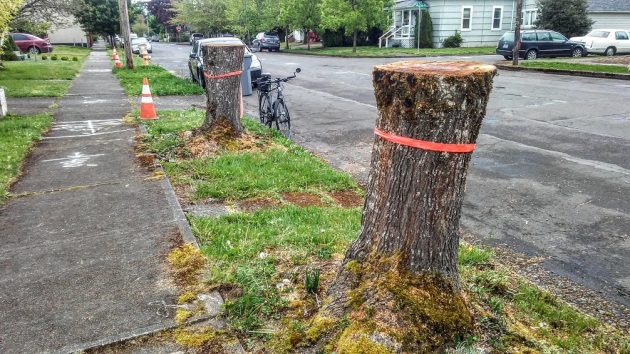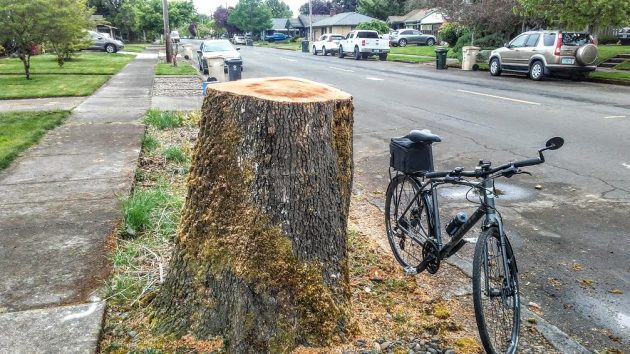
Stumps of street trees near the west end of Ninth Avenue on Friday.
They picked the week after Arbor Day to cut down more than a dozen street trees along Albany’s Ninth Avenue west of Elm Street. This spring or summer the street and sidewalks are going to be rebuilt.
It may not look like it from the pictures I took Friday, but for a quarter of a century Albany has won recognition for its management of trees. In her proclamation of April 24 as Arbor Day, Mayor Sharon Konopa pointed out that for the last 25 consecutive years, the National Arbor Day Foundation has recognized Albany’s stewardship of its urban forest by naming it a “Tree City USA.”
Sometimes stewardship means cutting trees down, especially when they cause trouble with sidewalks, and then planting new ones.
On Friday, I counted 17 stumps along Ninth between Elm Street and Lawnridge, most of them kind of thin and spindly, but also including three or four big ones.
In its winning bid of $1,387,485 for the street reconstruction contract, K&E Excavating of Salem included $30,700 for planting street trees and getting them established. (The tree removal was handled by somebody else.)
The contract doesn’t say how many trees are to be planted. But in any case, it will be a while before the replacements are as big as some of the ones cut down. (hh)
Today, May 5, City Engineer Staci Belcastro provided these additional details: “Just over 20 street trees have been removed on Ninth Avenue between Broadway Street and Elm Street in advance of the Ninth Avenue Street improvements project. … Construction is expected to begin this month.The project includes street reconstruction, a new water line, storm drain improvements, stormwater treatment swales, curb and gutter, and replacement of sidewalk and driveway approaches as required. Additionally, approximately 31 new street trees will be planted no later than November 15, 2020.

Looking east on Ninth near Lawnridge.

Cottage Grove has also been a Tree City USA for many years. The main way to acquire this designation is to apply for it. The biggest problem most urban tree managers face — other than damage to electrical lines, sidewalks, foundations, and streets caused by planting large, growing trees next to them — is people who plant forest trees next to their homes, streets, or powerlines. Forest conifers such as Douglas fir, redwoods, Sitka spruce, western hemlock, etc., do not stop growing for more than 100 years. They make terrible street trees or yard plantings for that reason alone, yet people keep planting them in urban settings. Other problems include intense shade (no other plants can grow adjacent to them), needle drop (acidic soil and regular clean up), and falling limbs and tops. Forest trees need to be regularly pruned, planted in reasonable locations, and/or replaced at relatively short intervals before they begin interrupting electrical service or damaging nearby structures. Otherwise they become nuisances and actual dangers during windstorms, ice storms, snowstorms, and/or advancing age. Not just my opinion, but a documented fact. Tree City USA evaluations should be taking these plantings into consideration, as well as focus on whether trees are providing habitat for native animals species or simply represent popular nursery species commonly found almost everywhere they can grow. Aesthetics are critical, but so are maintenance costs and plans.
If possible, I hope they would plant native trees, particularly oak (Quercus garryanna) as oaks have declined to 1% of their original area in the Willamette Valley since settlement, and that one species provides the single highest bird habitat.
John: I strongly agree that native plants should be used wherever possible. Not only do they provide proven growing ability in their native environment and desirable habitat for native birds, butterflies, and squirrels, but they give local character to the urban environment.
Japanese cherry blossoms are great in Washington DC, but they are seasonally messy and make all streets look the same. When I was on the Urban Tree Committee in Cottage Grove, every single “acceptable” tree species was from out of state and provided by nurseries producing them in large quantities. One size does not fit all and many of these trees have pests and growing habits (not to mention appearances) that are foreign to our cities and towns. Not a single native tree or shrub was listed as “acceptable.”
Oak are native to the region, grow very slowly, look great, and provide habitat for native animals. Vine maple does not get very large and has great Fall colors. Native ash, dogwoods (some possible disease problems), crabapples, rhododendrons, and wild cherry are other options. All good, but not in all locations.
A possible idea would be to curve the sidewalk away from the trunk to allow the tree to continue to grow. Yes, a curve would infringe a bit on someone’s lawn & involve a bit more expense….. But hey, try to grow a living thing like a tree. Then remove it for the convenience of a straight sidewalk.
Trees make for Great Neighborhoods. I’m sick at heart at the loose of these trees.
Cruise down 12th Ave SW from Pacific to Elm and count the number of dead trees, you will be saddened. If that alarms you, start looking around at all the dead trees. What’s up with that, you ask???